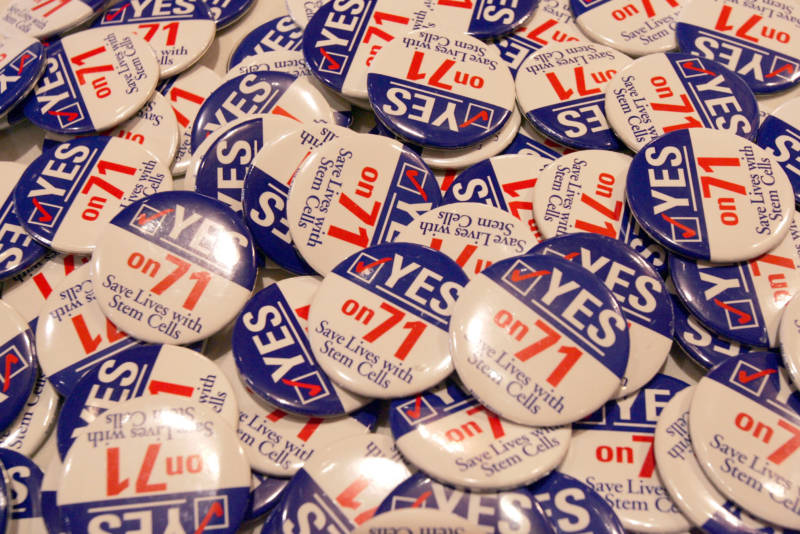"Basically, voters were led to believe in California that stem cell therapies were miraculous cures that were right around the corner," says David Jensen, a retired newspaper reporter, and prolific blogger who maintains the California Stem Cell Report. "But that didn't really reflect scientific reality."
CIRM's Kevin McCormack, director of public communications and patient advocate outreach, agrees that Proposition 71 advertising overpromised. "That's something [the agency has] had to live with," he says. "People always say, 'You promised us cures, where are they now?' One of the things I try to do is have people's expectations be hopeful, but realistic."
CIRM has around $900 million left of its $3 billion initial funding, which McCormack says will last about another five years at the current rate of spending. The agency has been under pressure the last several years to streamline the funding and research process. McCormack points to the 16 clinical trials the agency is currently funding, and a stem cell accelerator project recently announced. CIRM is also in discussion with the FDA, other stem cell organizations and patient advocacy groups to create a better system for regulating and approving therapies.
But the frustration many voters feel about CIRM may have more to do with the problematic way researchers, institutional communicators and the media talk about scientific progress in general, and stem cells in particular, than it does with the agency's performance.
"There has always been this high-stakes, extreme rhetoric around stem cells," says Timothy Caulfield, who teaches science and health policy at the University of Alberta. Caulfield says because stem cell research was so embattled, many spoke of its promise in hyperbolic terms.
"People had to make bold statements about the future of stem cells in order to counteract those that wanted to have strict laws to stop it. So you have to say, 'This is going to save lives. This is going to cure a variety of diseases.' Right from the beginning, the late '90s, you have that language appearing in the popular press."
Caulfield, who co-authored an opinion piece in Science titled "Confronting stem cell hype," and who researches the way scientific claims are exaggerated, says that even as the debate over the ethics of stem cell research has waned, a hyperbole hangover lingers. "We're still seeing all this breakthrough miracle language," he says.
Some in the scientific establishment are trying to tone things down. In May, the International Society for Stem Cell Research released updated guidelines for how stem cell science should be conducted, as well as how it should be communicated.
That effort may be facing long odds. There are systemic problems, Caulfield says, in how research is funded and promoted. He asserts that every step in the process of disseminating scientific information is driven by incentives to make progress sound a little rosier than reality.
"It's really the invisible hand of hype," he says. "In most cases these pressures are largely unconscious -- whether you're talking about the media, the researchers, the institutions or the funding agencies."
New and Improved Studies
Scientists are of course excited about their work and are under pressure from their institutions to publish. Abstracts (summaries placed at the beginning of research papers) have been shown to frequently feature a little extra oomph in promoting the research that follows. One study found that scientific abstracts containing eye-catching words like "innovative," "unprecedented," and "robust" were up nearly 900% in 2014 compared to 1974.
The press releases announcing researchers' findings go even further.
Caulfield says journalists, for lack of space or time, often leave out critical information like a study's small size, the difference between correlation and causation, and researchers' conflicts of interest. What results are stripped-down stories omitting important caveats, and that can produce more certainty than merited.
Such exaggerations make the stem cell field vulnerable to exploitation. "Once you move to the market the hype is brought up further," says Caulfield. For example, some clinics offer unproven and even dangerous stem cell treatments for everything from baldness to Lou Gehrig's disease.
What to do? Patients and health care writers and journalists should cultivate a healthy skepticism, for one. One source for a critical look at reported health studies is the watchdog site Health News Review, where an ABC News story reporting on stem cell therapy for muscular dystrophy was recently criticized for potentially inducing false hope in those who have the disease.
Individuals with this type of serious condition often feel desperate and short on time.
"I get calls every single day from people asking me if we have clinical trials for all manner of different diseases," says McCormack at CIRM. "Today it was a person calling about his mother who has Alzheimer's." He notes that CIRM is not currently running any trials for the disease.
"There is this sense of frustration," McCormack says. "They've been hearing about this work for 10 years and, why is it no nearer to being able to help people?"
The answer is that medical science works best when it proceeds cautiously, he says. And, undeniably, progress is being made in stem cell science, even if it seems slow. A search for stem cell clinical trials at ClinicalTrials.gov, for example, brings up 1,545 open trials, which are a necessary precursor to approval by the FDA.
Researchers like Michael Rudnicki, director of the Regenerative Medicine Program and the Sprott Centre for Stem Cell Research in Ottawa, believe that an age of new stem cell therapies does lie ahead.

